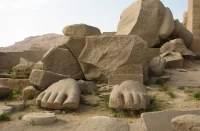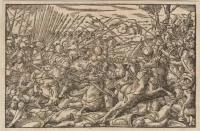Lately I have been strolling down memory lane, a favourite haunt of old men. And there I found a group of young children, boisterous boys, preparing to play a game. The game required a leader, and so they engaged in a ritual to determine which of them was “It” (always spelled with a capital “I”)—they “counted toes”.
For the uninitiated, the sacred and invariable ritual of counting toes worked like this: all the young boys gathered in a tight circle and put their feet together so that their feet formed a small circle as well. Then one of them would be the Counter (on my street the Counter was the boy who could multiply oaths more quickly than the other contenders—oaths such as “Had it!” Double stamp it! Touch red! All around the world!”). It was his coveted task to say the prescribed rhymes while counting the toes (the feet, actually) so that his hand touched a foot on each word of the rhyme. The last foot to be touched at the completion of the rhyme was “out”—i.e. the boy had to withdraw his foot from the circle. The last foot remaining belonged to the boy who was “It”.
The rhymes never varied in their wording, and changing the wording would have been a kind of cultural blasphemy, instantly disallowed by the unison shout of “That’s not how you say it!” Young boys were culturally conservative to the point of fundamentalism.
I remember several of the rhymes. One went “Engine, engine number nine, going down Chicago line. If the train goes off the track, do you want your money back?” The toe/foot touched at the word “back” had to answer yes or no, which was duly spelled out with more toe touching to determine the last toe out. Another rhyme was “My mother and your mother were hanging out clothes. My mother punched your mother right in the nose. What colour was the blood?” Any colour might be offered in answer (the reply of “red” was allowed, but smirked at as lacking in originality), and the colour duly spelled out.
 There were, apparently, variants of the textus receptus. On other streets and in other schools the received words for “Engine, engine number nine” were, “Engine, engine, number nine, running on Chicago line. See it sparkle, see it shine, engine, engine, number nine.” Doubtless each group of boys would’ve defended their version as “the real engine, engine number nine” and denounced the variant as heretical. It would be some time before we would be able to cope with the notion of equally legitimate variants and distinguish them from true distortions. Such distinctions, crucial to coping with the complex adult world, would have to wait. For us, the true Tradition was fixed and eternal and monochrome and allowed no variation. We were the Old Believers of our day.
There were, apparently, variants of the textus receptus. On other streets and in other schools the received words for “Engine, engine number nine” were, “Engine, engine, number nine, running on Chicago line. See it sparkle, see it shine, engine, engine, number nine.” Doubtless each group of boys would’ve defended their version as “the real engine, engine number nine” and denounced the variant as heretical. It would be some time before we would be able to cope with the notion of equally legitimate variants and distinguish them from true distortions. Such distinctions, crucial to coping with the complex adult world, would have to wait. For us, the true Tradition was fixed and eternal and monochrome and allowed no variation. We were the Old Believers of our day.
There were other rhymes as well, sometimes of a racist nature. One was “Eenie, meanie, miney moe, catch a tiger by the toe. If he hollers let him go. Eenie, meanie, miney moe”—except that we didn’t’ say “tiger”, but another word, one beginning with the letter “n”.
I mention this racism because it is important to the point I want to make. None of us boys were racist (which did not much redound to our credit, since in our school pretty much everyone was white and inter-racial relations, whether good or bad, could hardly ever occur). The racist word was retained not because of prejudice against other races, but because the word was a part of the rhyme, and we all knew that the words of a rhyme could not be altered. Obviously if we had been alive to the evils of racism, we would have omitted the rhyme.
Note: not changed the offending word to another (such as “tiger”), but omitted the rhyme entirely with the sage and youthful observation, “We shouldn’t say that. It’s not nice.” The rhyme need not be used, but it could not be changed. At least not on our street. The rhyme, whether used or not, whether current or outdated, was a part of Tradition.
This witnesses to the cultural conservatism of children and to the dynamics of Tradition. Children are naturally conservative in cultural matters, and that is why they are so open to (some would say “vulnerable to”) the traditions they receive when they are young. The rhymes we recited and the way they were used were for us an unquestioned part of local Tradition. And the function of Tradition was not simply to facilitate leaders in games of tag; Tradition (though we could not know it then) functioned to provide a worldview. It witnessed to how the world worked, to The Way Things Are and to The Way Things Are Supposed To Be. Hence the importance of early pedagogy.
We see this in the Scriptures. Proverbs 22:6 observes, “Train up a child in the way he should go and even when he is old, he will not depart from it”, which is usually interpreted as a counsel to teach children their values at a young age.
Deuteronomy 6:6-7 counsels fathers as follows: “These words, which I am commanding you today, shall be on your heart. And you shall repeat them diligently to your sons and speak of them when you sit in your house, when you walk on the road, when you lie down, and when you rise up.”
In other words, a father should teach his son (and in that culture, a mother her daughter) the needed values as a part of the family’s daily routine. That is how true tradition functions. It is not passed along merely at set times as part of a religious occasion, but constantly, as the members of the family go about their daily tasks. Words are to be sprinkled through daily inter-actions, such as casual chat while walking down a road to school, or lying down and tucking the kids into bed, or rising up and getting ready for a new day. The casualness with which the teaching is offered is an essential part of the pedagogy. The teaching is thus presented not as a separate lesson, but as part of How Things Are. The Tradition becomes a part of the child’s unconscious worldview, long before the child is aware that it has a worldview.
Like the invariability of childhood’s rhymes for counting toes, such parental teaching is similarly sancrosanct. Formal lessons can be accepted or rejected, but an early and continuous stream of chat, observation, and evaluation offered while walking down the road with dad or being tucked into bed by mom are less subject to scrutiny. They are more likely to become the lens through which the child sees the world.
Herein, of course, lies the problem, for the secular world around us also keeps up a continuous stream of chat, observation, and evaluation, a kind of rival pedagogy to that offered by Christian parents. Parents must be aware of this rival and poisonous stream, and perhaps offer rebuttal and antidote in their own ongoing pedagogy. Home-schooling is one way to minimize secularism’s rival worldview, but home-schooling alone is not enough. Sooner or later children must enter the world outside the family and be immersed in the secular stream. It is therefore all the more important for dad to have spoken in the house, and while walking on the road, and when lying down, and when rising up.
The cultural conservatism of children is a fact of history, and wise parents can tap into it to protect their children from the poisonous lies of this age. Young boys may or may not count toes any more (I wouldn’t know, since I had girls and not boys), but young hearts remain the same. It is into those young hearts that we must pour our saving Tradition—a Tradition as unvarying as the true colour of blood.
Source: No Other Foundation














Comments